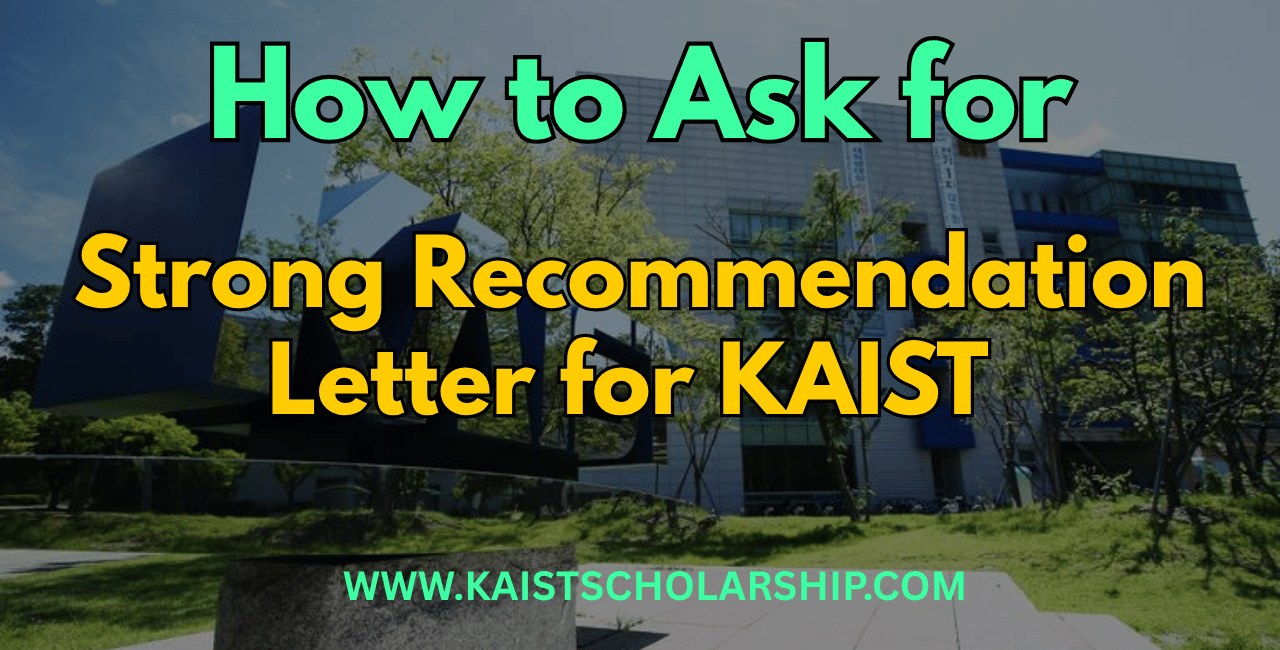How to Ask for a Strong Recommendation Letter for KAIST
A good recommendation letter is very important for your KAIST scholarship application. It shows your academic skills your personality and your potential as a student.
Many students do not know how or when to ask for one. Because of this they often get weak or generic letters that do not help their application.
Keep it simple and clear. Make sure to ask the right person at the right time to get a strong letter that supports your goals.
This guide walks you through:
- Who to ask
- When and how to ask
- What to provide
- PLUS real email templates you can copy and use
Let’s make sure you get a letter that truly supports your KAIST application.
Why Recommendation Letters Matter at KAIST
KAIST places high value on academic ability, discipline, and future potential — all of which are hard to prove through grades alone. That’s why a recommendation letter gives context to your achievements and helps reviewers assess:
- Your academic performance
- Research potential (for graduate applicants)
- Work ethic, curiosity, and integrity
- Soft skills like communication or leadership
For graduate applicants (MS/PhD), a research-focused letter is especially critical.
Who Should You Ask?
Choose someone who:
| Role | Why They’re Ideal |
|---|---|
| Teacher or Professor (recent) | Knows your academic strengths |
| Research Supervisor | Can speak about projects or papers |
| Academic Advisor | Understands your long-term goals |
| Internship Mentor (if relevant to your field) | Shows applied experience |
Avoid family friends, employers from unrelated fields, or religious/community leaders unless they directly taught or supervised you in an academic context.
When Should You Ask?
Ask at least 4–6 weeks before the KAIST deadline (typically December for Spring intake).
| Timeframe | Action |
|---|---|
| Aug–Sep 2025 | Identify recommenders |
| Sep–Oct 2025 | Send formal request + supporting documents |
| Nov 2025 | Follow up politely and confirm submission |
| Before Deadline | Cross-check that letter was submitted correctly |
What to Provide Your Recommender
Make it easy for them to write a strong, specific letter. Give:
- Your CV/Resume
- Draft of your SOP
- A brief paragraph on your goals at KAIST
- The submission deadline
- Instructions from KAIST (e.g., link, upload portal, email address)
- Your transcript (optional, if they ask)
This shows you’re serious, organized, and respectful of their time.
Email Templates: Asking for a Letter
Email #1 – Initial Request (Polite & Professional)
Subject: Request for Recommendation Letter – KAIST Scholarship 2026
Dear [Professor’s Name]
I hope you are doing well. I am applying for the [Program Name] at KAIST for 2026 and I would really appreciate it if you could write me a recommendation letter.
I took your [Course Name] and worked on [mention any projects/research]. I think you can speak about my academic skills and my ability to succeed in this program.
I have attached my resume a draft of my SOP and some details about the program. The deadline is [Date] and the letter should be submitted through [Link or Method].
Please let me know if you can help me with this. Thank you so much.
Best regards
[Your Full Name]
[Your Contact Information]
Email #2 – Follow-up Reminder (Polite & Gentle)
Subject: Friendly Reminder – KAIST Recommendation Letter
Dear [Professor’s Name]
I hope you are doing well. I wanted to check in about the recommendation letter for KAIST that I asked you about. Just a reminder the deadline is [Date].
If you need any more details from me please let me know.
Thank you so much for your help. I really appreciate it.
Best regards
[Your Full Name]
Common Mistakes to Avoid
| Mistake | Fix |
|---|---|
| Asking too late | Ask at least 4–6 weeks before the deadline |
| Giving no context or materials | Always attach resume, SOP, and summary |
| Choosing the wrong person | Avoid teachers who barely know you |
| Not confirming submission | Politely follow up 1–2 weeks before deadline |
| Forgetting the method (online/email) | Send KAIST’s official instructions |

